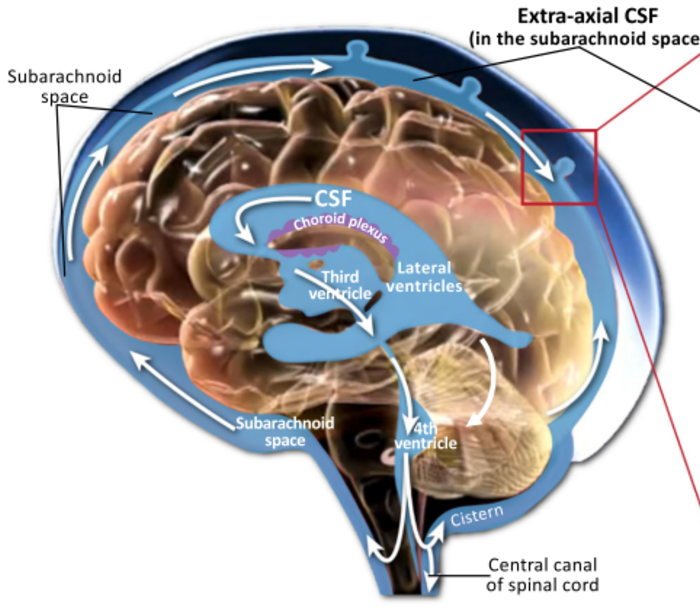Scientists don’t have all the answers all the time. Our bodies are so complex that it’s a fallacy to think that we know how our bodies fully operate. We don’t. And when we have wrong information, we can make really bad decisions because we didn’t understand the entire situation.
This is happening in the scientific world specifically regarding Cerebrospinal Fluid.
Maybe you remember learning at school that Cerebrospinal Fluid was to protect the brain against impacts. It does do that, too. But in the last five years, scientists also discovered that Cerebrospinal Fluid delivers growth factors to the brain to ensure neuronal health and removes neurotoxins and metabolic waste byproducts of normal neuronal function. That’s a lot of really important things that the Cerebrospinal Fluid does. Let’s get into this cutting-edge science – it’s pretty exciting.
Cerebrospinal Fluid and Autism.
This is absolutely cutting-edge research on autism and the conclusion I think you will find very, very interesting. Let’s get started.
Cerebrospinal Fluid Purpose: The two primary functions of the Cerebrospinal Fluid are delivery of growth factors and other molecules needed for healthy neuro-growth.
And this is a direct quote:
“Cleaning of the brain by removing neurotoxins and metabolic waste byproducts of neuronal function.”
That’s a direct quote from the actual publication.
Detox has become such a buzzword, right? You just hear it all over the place, like, oh, let’s drink some celery juice and detox. But there is real science on detox. Our brain needs to detox. Our body needs to detox. And it’s not so much of a kind of cartoonish representation of life. Detoxing is absolutely important, and it’s not necessarily just toxins and all this kind of bad stuff that’s in the environment. Our bodies need to clean up from just the normal, regular biological processes. Detox doesn’t have to be considered as something exotic. It’s vital for our bodies.
CSF and Growth Factors
The CSF system originates in the first few weeks of gestation, and that’s when the neural tube closes and is filled with Cerebrospinal Fluid(CSF). What’s really cool is as this tube elongates, it forms the central canal of the central nervous system. I don’t know. Many times the central nervous system just seems ambiguous. It’s just this kind of, I don’t know, unseen highway. But what happens is one end becomes the ventricles in the brain – this tube, so one end becomes the ventricles in the brain, and the other end becomes the spinal cord.
CSF is continually produced in the ventricles in our brain, where it delivers signaling molecules to certain cells which become immature neurons. And then those immature neurons migrate, aggregate, and differentiate to form parts of the brain. It’s pretty amazing.
CSF Balance
CSF is produced throughout our lifetime and needs to be continuously balanced by the corresponding absorption of CSF. This is really cool math. The brain produces 500 cubic centimeters per day of CSS. The brain can hold 150, and a fresh batch of CSF is produced and recycled four times per day!! Talk about high volume there.
CSF Flow
Alright, let’s get into the CSF flow a little bit more. We got to at least have one figure of the brain here.
The majority of the CSF volume in the brain is in this space here. And this is why originally, most scientists thought that the CSF, the only purpose was for impact shielding of the brain. Originally, that’s all that was thought of this powerful liquid in our brain. It was originally just thought to be protecting the brain against impact. It does so much more.
Alright, 25% is in the ventricles. The ventricles are more in the central part of the brain. And so you have flow, balance, and detox. All of these functionings are absolutely vital to optimal brain growth and development.
MRI, CSF, and Autism
Let’s start looking into the brain. MRI can measure the volume of the different CSF compartments to get a better understanding of any CSF unbalance. Either in the production or the absorption. And you can see this will become more and more important as we get into the research of CSF.
A small study showed that at six months, infants who later developed autism had increased CSF. The increase remained at twelve months and 24 months of age and was associated with more severe autism symptoms at diagnosis at 36 months.
CSF volume really does have an impact on life. This suggests that the severity of CSF increase is associated with the severity of later autism symptoms. That’s pretty profound. Now, these were small studies. You can’t extrapolate this for every person with autism, but the evidence is starting to show, and to be able to get an understanding of how someone’s brain is doing at six months, rather than waiting for three years or four years or five years, is pretty profound.
CSF, Behavior and Autism
If you summarize the infant brain studies, they show that infants who later develop autism have elevated levels of CSF at six months, increased growth rate between six and twelve months, and total brain volume overgrowth between twelve and 24 months of age. According to all of that research (those are several different studies), brain changes in autism are present during the period prior to diagnosis, and that is preceding behavioral differences.
Unfortunately, right now, it is very hard to get a diagnosis without behaviors associated with it. Right? There’s no blood test for autism. There’s no urine test, no stool test. There’s no test whatsoever for autism except for once there are behaviors – that’s when a diagnosis is made.
And so this research is saying that the brain changes are occurring before the behavior changes happen. That’s why this is so exciting. Hopefully, we don’t have to wait for these behavioral differences. We want to start to get a jump on autism diagnosis. Diagnose it earlier and have a good plan of action.
At six months of age, brain size is normal, but there is an excessive amount of CSF. This is a time when the first behavioral differences in autism are detectable. The first behavior change that these studies are showing is motor delays.
Between six and twelve months of age, there’s a rapid expansion of the cortical service area, which is also happening at the same time that sensory and attention problems start to become more and more prevalent. Right. We’re not technically at behavior problems yet. This is now we’re getting into the sensory and attention and focus visual processing and starting to miss social cues a bit.
Conclusion
This is a direct quote from the paper:
“Early changes in brain development in the first year of life coincide with the age when early sensor, motor and visual orienting differences tend to emerge, which are followed by social deficits in the second year of life and the consolidation of behaviors that are diagnostic of autism.”
Cerebrospinal Fluid is vital for the optimal development of a person’s brain as well as detoxing, which helps with the development of the brain. And so if that is off, then there’s a cascade that happens. Typically, motor delays are what’s first, then sensory, and then that’s when it progresses into those larger type behaviors where autism can be diagnosed. This is really giving a granular view into the brain. And again, this is not necessarily for every single person with autism. These studies were of a small size. And if you want to learn more about MRI, I do have a video on MRI and autism. And if you want to learn more about Cerebrospinal Fluid and sleep, I also have a video on that.
Reference
And here is the reference that I’ve used:





